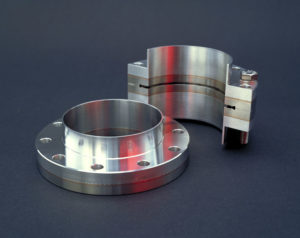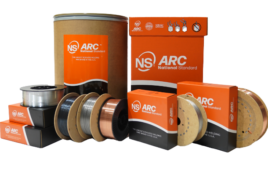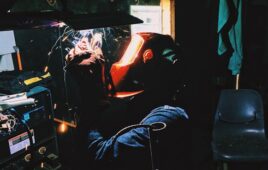Written by Jed Bothell, Vice President
Atlas UHV

The bimetal machining process at work.
Bimetal fittings, joints, and couplings of all types are used in a wide variety of industries including vacuum, cryogenic, semiconductor, aerospace, nuclear, oil and gas, and medical markets to enable product developers an easier transition — typically, from stainless steel to aluminum.
Other metal combinations available include aluminum-to-copper and aluminum-to-titanium bonding. OEMs and end-users often require standard and custom bimetal components that will not break down under the stress of high vacuums and varying temperatures.
Where adhesives provide a solid bond at the beginning of use, they degrade over time. Metallic bonds through electron sharing eliminate this concern, allowing engineers to apply components that offer outstanding thermal conductivity, lightweight, non-magnetic, better vacuum capabilities, and excellent machinability of aluminum for hermetic gas, vacuum, liquid, and beam lines.
Dissimilar bonding
The process of joining aluminum to other metals is generally quite challenging. Its tenacious oxide surface protects it from rust-like oxidation, which is visible on iron and steel, preventing close metal-to-metal contact.
Aluminum’s high-chemical reactiveness also causes it to form intermetallic compounds with many metals rather than metallic bonds. Intermetallic compounds are extremely brittle and can easily crack or shatter. Also, aluminum has a low melting temperature compared to other metals, making welding aluminum to another metal difficult.
Atlas Technologies has developed two primary techniques to bond aluminum to other metals:
1. Explosion bonding or welding (EXW): a solid-state process by which dissimilar metals can be joined together at an atomic level.
2. Diffusion bonding (DB): a process whereby different metals are placed together with extremely high pressure and heated to an elevated temperature for a specific duration.

Bimetal components offer an easier transition from stainless steel to aluminum, providing an advantage in several industries including the vacuum, cryogenic, and semiconductor sectors, and others.
The company has developed new bonding processes that enable more sophisticated components to be built and perfected their machining skills that ensure tight tolerances for precision applications.
Benefits of EXW & DB
Bonded parts provide a range of advantages when using highly critical equipment. These parts can be used in hermetic, ultra-high, and extremely high vacuum systems. They’re cryogenic compatible (to as low as liquid helium temperatures) and are capable of retaining superfluid liquid helium.
Some bonds can support peak temperatures of 400° C (572° F) while providing high-strength joints. Since such bonds are 100% metallurgical any failure is typically found in the parent material and unrelated to the bond since they are chemically pure.
Additionally, because no additional chemicals — such as adhesives, bonding agents, or brazes are used — the bonds are well suited for ultra-high vacuum and space applications. This is significant because the outgassing of adhesives can weaken bonds and contaminate the process. Also, since aluminum does not braze to other metals there’s no contamination from fluxes commonly used in brazed joints.
By using EXW or DB, the aluminum/stainless, aluminum/copper, and aluminum/titanium joints have no heat-affected zones (HAZ). HAZ are melt or excessive heat zones near or at the dissimilar metal joint that can weaken the strength of the bond.
Additional considerations
Aluminum is a difficult metal to join, which is why bimetallic bonding for ultra-high vacuum applications is a practical approach. But there are limitations.
For example, in terms of size, EXW requires that the flyer plate must be thinner than the base plate. The bonding process is violent and creates a considerable amount of damage to the outside of the bonded plates and produces edge effects where there may be no bond, so it’s not ideal or economical to bond extremely small plates.
Diffusion bonding can bond any plate’s thickness to any other plate’s thickness. This means that when using diffusion bonding, it’s possible to produce net-shaped parts. What’s more, is that it’s also possible to bond finished parts depending on the geometry.
However, unlike EXW, it’s often more efficient to bond near net shapes and performs light finish machining afterward. Also, the area of the bond zone is relatively limited compared to EXW.
Galvanic reactions can occur with any dissimilar metals that are placed in a conducive solution or vapor. If the bonded interface is immersed in Deionized water or a non-conductive solution, galvanic corrosion will not occur.
Interestingly, aluminum and steel explosion welded strips are used to make all welded joints between the hulls of steel ships and aluminum pilot houses because the joint has zero porosity. Porosity is where the corrosion occurs, consequently, there’s less corrosion than if the aluminum were bolted to the steel.

Bonded metal flanges reduce CTE mismatch by enabling aluminum tubes and chambers to be joined with flanged joints, so that both side of the joint are stainless.
There can be large differences between the coefficient of thermal expansion between aluminum and stainless steel but the bonds are capable of withstanding those stresses. In fact, it’s been found that Atlas flanges and ATCR fittings reduce CTE mismatch by enabling the aluminum tubes and chambers to be joined with flanged joints such that both sides of the joint are stainless.
When machining EXW and diffusion bonded components the machining feeds and speeds must be adjusted for contact with each separate metal. There can also be a considerable amount of residual stress placed on the adjoining metal particularly in EXW parts. But there are methods to reduce the stresses to gain the required tolerances.
It’s also worth noting that the explosion processes can work-harden the stainless steel, which makes machining more challenging.
For applications with electrical conductivity, bonds can provide conductivity because there are few intermetallic compounds or voids that limit it. This is useful for electrical bus bars.
Typical applications
The parts are suited for cryogenics because they’re hermetic to ultrahigh vacuum levels, even in liquid helium (superfluid). The bonds also have the strength to withstand the huge stresses in differential coefficients of thermal expansion. So, EXW and diffusion bonded components are ideal for any applications that require high to ultra-high levels of vacuum, such as quantum computers, medical equipment, particle accelerators, satellites, simulation chambers (for devices going into deep space),
Bimetal components do not require bolting or the use of an adhesive. Advanced joining technologies enable engineers to reliably apply the ideal properties of one metal with those of another.
Bimetallic joints can be used to combine corrosion resistance, higher thermal conductivity, lightweight, low cost, machinability, and several other properties not found in any one metal. With bimetallic joints, engineers can make a metallic composite material that enables them to attain the highest performance and maximum value.





Tell Us What You Think!